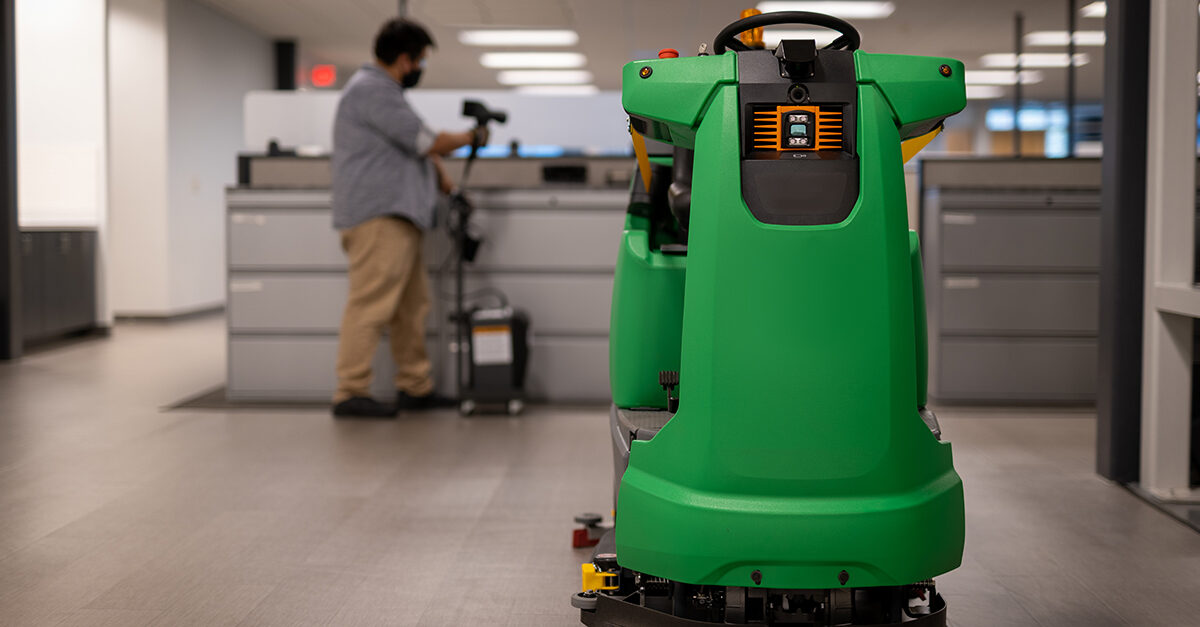While relatively new to the cleaning industry, autonomous mobile robots (AMRs) can help improve cleaning efficiency and quality. Unlike automatic scrubbers that require human oversight, AMRs function without hands-on operation to enhance the work of cleaning staff. They are specifically designed for repetitive floor cleaning and operate via a connection between the scrubber and a smart device. This connection allows workers to set the machine to autonomous mopping, sweeping, or scrubbing in a designated area.
AMRs are particularly beneficial for larger facilities such as grocery stores, warehouse and logistic centers, and higher education buildings. These structures tend to have high-traffic areas that require regular cleaning, and the vast square footage of their hard floor surfaces gives these robots plenty of room to maneuver. To date, micro-rider floor scrubbers powered by BrainOS® software have autonomously cleaned more than 100 billion square feet and counting.
Building AMRs into workloading efforts can provide additional benefits, especially when it comes to saving time and labor. The AMRs clean the most time-consuming areas, while employees focus on cleaning and disinfecting detailed, high-touch areas.
Connect workloading and automation
At a basic level, workloading involves leveraging verified productivity rates to determine what areas of a facility the staff needs to clean and how long it should take to complete specific tasks. ISSA, the worldwide cleaning industry association, has developed The Official ISSA Cleaning Times, a resource that assigns times to specific cleaning jobs.
In addition to determining how long cleaning tasks take, workloading answers other questions, including:
- What areas and surfaces are workers cleaning?
- What equipment are they using to clean?
- What is the process for cleaning or maintaining the area?
- Who is performing the task and where?
Workloading is not just about individual tasks—which are important and need to be accounted for—but more importantly, how tasks tie together in the flow of the cleaning staff’s workday.
Effectively adding robots to a cleaning program requires a shift in mindset and facility culture. According to the ISSA Cleaning Industry Management Standard (CIMS), 55% of a facility’s operational budget is labor. Therefore, it is important to have employee buy-in before introducing AMRs. Labor retention is already a challenge in the industry, so facility managers and building service contractors (BSCs) need to reinforce the value of their staff. The key is to reassure employees that the AMRs won’t replace their jobs, but rather augment their positions and prepare them for higher-level career opportunities.
As team culture can shift with the addition of AMRs, engaging cleaning staff in the planning stages of implementation can help keep the culture positive. Make sure staff members realize that AMRs remove the time-consuming floor cleaning tasks from their daily routine and introduce efficiencies into their workflow. Staff can now focus on detailed work that may have been difficult to complete before.
Create a checklist for implementation of robots
Implementing AMRs requires attention to several details to get the best results—not only as it applies to the equipment, but also to the cleaning staff.
Identify capabilities—First, identify what the AMR can do during a work shift. For example, an autonomous scrubber’s purpose is to maintain hard floor surfaces. Look at the large spaces where the AMR could replace manual mopping or the need for a worker to walk behind an automatic scrubber. This provides insight into how staff could shift their focus to other tasks.
Test the AMR—Ensure AMRs integrate into the cleaning program based on real-life deployment. Select and test different floor cleaning scenarios, calculate the time it takes to complete the task, and add obstacles that could impact timing and performance.
Set up different traffic patterns and changes within the built environment such as rearranging furniture or altering soil types on the floor. Also, be sure to test the AMR’s operation during different times of the year since temperature and humidity can affect operation.
Set expectations—Many facilities do not have up-to-date quality assurance expectations. When integrating an AMR, communicate expectations to employees about the importance of detailed cleaning they will take on while the AMR handles the routine floor cleaning.
Provide training—Even though AMRs take care of hard-surface floor cleaning, employees are responsible for setting them in motion. Provide thorough training on how to set the machine to its tasks and how to address any stoppages. Cleaning crews will receive a stoppage alert on their smart device and need to know how to troubleshoot quickly to maintain efficiencies.
Support certification—Facility visitors are looking at in-house providers and BSCs as the cleaning experts. Highly knowledgeable workers are a benefit to the team. Enrolling them in certification courses increases their skills while also making a positive impact on company culture.




